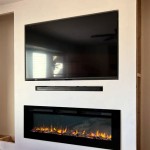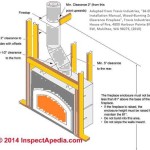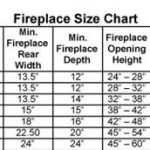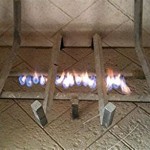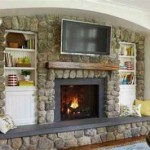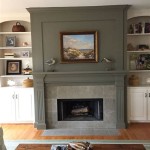How To Install a TV Above a Gas Fireplace
Mounting a television above a gas fireplace has become an increasingly popular design choice, blending entertainment and ambiance within a living space. However, this installation requires careful consideration due to the potential heat exposure from the fireplace and the structural requirements of the wall. Improper installation can lead to damage to the television, the fireplace, or the wall itself, as well as potential safety hazards.
This article provides a comprehensive guide on how to safely and effectively install a television above a gas fireplace, covering essential considerations, necessary tools and materials, and a step-by-step installation process. It will address potential challenges and offer solutions to ensure a successful and aesthetically pleasing outcome. Prior to undertaking this project, understanding local building codes and regulations related to fireplace and electrical installations is imperative.
Key Considerations Before Installation
Before commencing the installation process, several crucial factors must be thoroughly assessed to determine the feasibility and safety of mounting a TV above a gas fireplace. These include heat exposure, viewing height, structural integrity, and electrical requirements.
Heat Exposure: The most significant concern when mounting a TV above a gas fireplace is the potential for heat damage. Televisions are electronic devices sensitive to high temperatures, and prolonged exposure to excessive heat can shorten their lifespan or cause irreversible damage. The heat emanating from a gas fireplace can be substantial, particularly during extended use. It's crucial to measure the temperature of the wall above the fireplace while the fireplace is operating at its highest setting for a prolonged period (e.g., an hour). Some manufacturers recommend a specific maximum temperature for safe operation. If the wall temperature exceeds this limit, mounting the TV directly above the fireplace is not advisable. Mitigation strategies may include installing a heat shield, increasing the distance between the fireplace and the television, or opting for a different location for the TV. Consider the BTU output of the fireplace. Higher BTU fireplaces produce more heat and increase the risk to the television.
Viewing Height: Optimal viewing height is another critical consideration. Neck strain and discomfort can result from positioning the TV too high. Ideally, the center of the television screen should be at eye level when seated. When mounting above a fireplace, this often necessitates angling the TV downwards using a tilting mount to compensate for the higher position. Carefully measure the distance from the floor to the viewer's eye level when seated and calculate the appropriate height for the TV accordingly. A mock placement using cardboard that is a scale of the tv is helpful to determine ideal placement.
Structural Integrity: The wall above the fireplace must be capable of supporting the weight of the television and its mounting bracket. Most fireplaces are surrounded by a wall, often constructed of drywall over wood studs or, in some cases, brick or concrete. It is imperative to locate the wall studs and secure the mounting bracket directly to them using appropriate lag bolts or screws. If the wall is brick or concrete, specialized masonry anchors will be required. Using a stud finder is essential for locating studs behind drywall. If unsure about the wall's structural capacity, consulting a qualified contractor is recommended.
Electrical Requirements: A dedicated electrical outlet will be needed near the mounting location to power the television. It is crucial to avoid running extension cords across the floor or behind the fireplace, as these pose a safety hazard and are often prohibited by building codes. If an outlet is not already present, a licensed electrician should install one. Furthermore, consider the placement of cable and internet connections. Running these cables behind the wall for a clean look can be accomplished by installing conduit during the initial stages of the project. Ensure all electrical work complies with local codes and regulations.
Tools and Materials Required
A successful TV installation above a gas fireplace requires a specific set of tools and materials. Gathering these items before starting the project ensures a smooth and efficient process.
Tools:
- Stud finder: To locate wall studs.
- Level: To ensure the TV is mounted straight.
- Drill: With various drill bits for wood, metal, or masonry, depending on the wall construction.
- Screwdriver: Phillips head and flathead screwdrivers.
- Socket wrench: For tightening lag bolts.
- Measuring tape: To accurately measure distances and mark locations.
- Pencil: For marking locations.
- Wire stripper: To prepare electrical wires (if installing an outlet).
- Cable crimper: For terminating coaxial cables (optional).
- Fish tape or cable rod: To run wires through walls.
- Safety glasses and gloves: To protect eyes and hands.
Materials:
- TV mount: A suitable mount that is rated to carry the weight of the TV and allows for tilting is preferred.
- Lag bolts or masonry anchors: Depending on wall construction.
- Electrical outlet and wiring: If installing a new outlet.
- Cable management accessories: Wire ties, cable concealers, or in-wall cable management kits.
- Heat shield (optional): If heat exposure is a concern.
- Drywall patch kit (optional): For repairing any holes.
- Paint (optional): To match the wall color after patching.
Prior to commencing the installation, verify that all tools are in good working condition and that all materials are compatible with the specific TV and wall type. It is recommended to purchase high-quality components to ensure a safe and durable installation.
Step-by-Step Installation Process
The following steps outline the process for installing a television above a gas fireplace. Adhering to these steps and exercising caution throughout the process minimizes the risk of errors and ensures a safe and professional installation.
Step 1: Preparation and Safety Precautions: Begin by turning off the power to the circuit breaker that supplies electricity to the fireplace and the area where the TV will be mounted. This is a critical safety measure to prevent electrical shock. Clear the area around the fireplace and protect the floor with a drop cloth or other protective covering. Ensure adequate ventilation as dust and debris will be generated during the drilling process. Review the instructions provided by the TV mount manufacturer and familiarize yourself with the mounting process. Have all tools and materials readily accessible.
Step 2: Locate Wall Studs and Mark the Mounting Location: Use a stud finder to accurately locate the wall studs. Mark the locations of the studs with a pencil. Determine the desired height for the TV, keeping in mind the optimal viewing height and the distance from the fireplace. Use a level to draw a horizontal line at the desired height. This line will serve as a guide for positioning the TV mount. Position the TV mount bracket against the wall, aligning it with the marked stud locations and the horizontal line. Use a pencil to mark the locations for the mounting holes.
Step 3: Install the TV Mount: Pre-drill pilot holes at the marked locations using a drill bit appropriate for the wall material (wood, brick, or concrete). Ensure the pilot holes are deep enough to accommodate the lag bolts or masonry anchors. Secure the TV mount bracket to the wall using the appropriate fasteners. For wood studs, use lag bolts that are long enough to penetrate deep into the stud. For brick or concrete, use masonry anchors specifically designed for the weight of the TV. Use a socket wrench to tighten the fasteners securely. Verify the mount is level using a level.
Step 4: Attach the Mounting Brackets to the TV: Following the TV mount manufacturer's instructions, attach the mounting brackets to the back of the television. Ensure the brackets are securely fastened and properly aligned. Verify the screws used are the correct size and length for the TV's mounting holes. Over-tightening can damage threads or the TV casing. Often, the TV manufacturer will include mounting hardware for this step.
Step 5: Connect Wiring and Cables: Before mounting the TV to the wall bracket, connect all necessary cables, including the power cord, HDMI cables, and any other signal cables. This is easier to do before the TV is mounted. Run the cables through any cable management accessories, such as wire ties or cable concealers, to keep them organized and prevent them from hanging loosely. If running cables through the wall, use fish tape or a cable rod to guide the cables through the conduit or opening. Ensure the cables are long enough to reach the necessary connections.
Step 6: Mount the TV to the Wall Bracket: Carefully lift the television and align the mounting brackets on the back of the TV with the corresponding slots on the wall-mounted bracket. Secure the TV to the wall bracket according to the manufacturer's instructions. This typically involves sliding the TV into place and securing it with locking screws or latches. Ensure the TV is securely mounted and cannot be easily dislodged.
Step 7: Cable Management and Cleanup: Neatly arrange the cables behind the TV using cable ties or other cable management accessories. Conceal any exposed cables using cable concealers or in-wall cable management kits. This creates a clean and professional appearance. Turn the power back on at the circuit breaker and test the television to ensure it is functioning properly. Clean up any debris or dust generated during the installation process. Dispose of all packaging materials properly.
Step 8: Post-Installation Checks: Once the installation is complete, verify that the TV is level and securely mounted. Conduct a heat test by operating the fireplace at its highest setting for an extended period. Monitor the temperature of the wall above the fireplace to ensure it remains within the TV manufacturer's recommended operating range. If the temperature exceeds the limit, consider installing a heat shield or adjusting the fireplace settings to reduce heat output.
Troubleshooting Common Issues
During the installation process, several common issues may arise. Understanding these potential problems and having solutions readily available can streamline the process and prevent delays.
Difficulty Locating Wall Studs: If a stud finder is not accurately detecting wall studs, try using a different stud finder or manually tapping on the wall to listen for a solid sound, which indicates the presence of a stud. Alternatively, carefully drill small pilot holes until a stud is located. Once one stud is found, the remaining studs are typically spaced 16 or 24 inches apart. Account for variances in stud placement, especially in older homes.
Inadequate Fasteners: If the provided fasteners are not suitable for the wall type, purchase alternative fasteners that are specifically designed for the wall material. Ensure the replacement fasteners have the appropriate weight rating for the TV and mounting bracket. For brick or concrete walls, use high-quality masonry anchors that are designed to withstand the tensile forces. If significant damage is done to the wall, consult a professional contractor.
Cable Management Problems: If running cables through the wall proves difficult, use a longer fish tape or cable rod. Lubricating the cables with cable lubricant can also facilitate their passage. If the existing conduit is too narrow, enlarge it or install a larger conduit. Consider employing wireless HDMI transmitters to reduce the number of cables required. Make sure your connections are secure and labeled before concealing them behind the wall.
Mounting Bracket Instability: If the mounting bracket is not securely attached to the wall, double-check that the fasteners are properly tightened and that the bracket is aligned with the studs. If the wall is weak or damaged, reinforce it with additional wood or metal supports. Consider consulting a professional contractor to assess the structural integrity of the wall. Applying construction adhesive between the bracket and the wall offers additional support, but care must be taken to avoid damaging the wall when removing the mount in the future.

Can I Mount My Tv Above The Fireplace

Can I Mount A Tv Over My Fireplace Forshaw Of St Louis

Everything You Need To Know About Tv Mounts For Fireplaces

Can I Mount My Tv Above The Fireplace

Mounting Your Tv Above Fireplace

ᑕ❶ᑐ What To Consider Before Mounting A Tv Above Fireplace

3 Tips For Installing A Tv Over Your Fireplace

ᑕ❶ᑐ What To Consider Before Mounting A Tv Above Fireplace

Tv Wall Mount Installation With Wire Concealment Over Fireplace

Mounting A Tv Above Fireplace 5 Things To Consider
Related Posts

